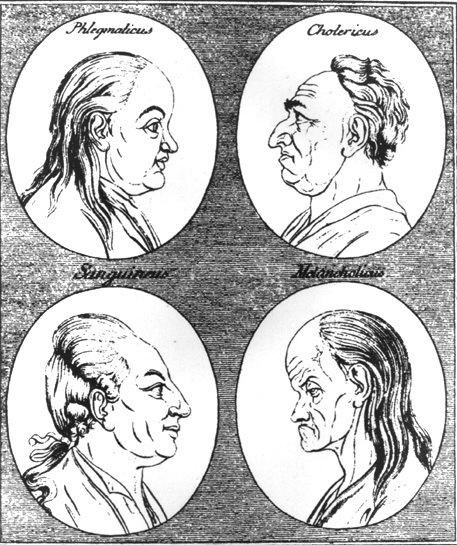 | ||
Four temperaments is a proto-psychological theory that suggests that there are four fundamental personality types, sanguine (enthusiastic, active, and social), choleric (short-tempered, fast, or irritable), melancholic (analytical, wise, and quiet), and phlegmatic (relaxed and peaceful). Most formulations include the possibility of mixtures of the types.
Contents
The Greek physician Hippocrates (c. 460 – c. 370 BC) incorporated the four temperaments into his medical theories as part of the ancient medical concept of humorism, that four bodily fluids affect human personality traits and behaviors. Later discoveries in biochemistry have led modern medicine science to reject the theory of the four temperaments, although some personality type systems of varying scientific acceptance continue to use four or more categories of a similar nature.
History and development
Temperament theory has its roots in the ancient four humors theory. It may have origins in ancient Egypt or Mesopotamia, but it was the Greek physician Hippocrates (460–370 BC) who developed it into a medical theory. He believed certain human moods, emotions and behaviors were caused by an excess or lack of body fluids (called "humors"): blood, yellow bile, black bile, and phlegm. Next, Galen (AD 129 – c. 200) developed the first typology of temperament in his dissertation De temperamentis, and searched for physiological reasons for different behaviors in humans. He classified them as hot/cold and dry/wet taken from the four elements. There could also be "balance" between the qualities, yielding a total of nine temperaments. The word "temperament" itself comes from Latin "temperare", "to mix". In the ideal personality, the complementary characteristics or warm-cool and dry-moist were exquisitely balanced. In four less ideal types, one of the four qualities was dominant over all the others. In the remaining four types, one pair of qualities dominated the complementary pair; for example, warm and moist dominated cool and dry. These latter four were the temperamental categories Galen named "sanguine", "choleric", "melancholic" and "phlegmatic" after the bodily humors, respectively. Each was the result of an excess of one of the humors that produced, in turn, the imbalance in paired qualities.
In his Canon of Medicine (a standard medical text at many medieval universities), Persian polymath Avicenna (980–1037 AD) extended the theory of temperaments to encompass "emotional aspects, mental capacity, moral attitudes, self-awareness, movements and dreams."
Nicholas Culpeper (1616–1654), described the humours as acting as governing principles in bodily health, with astrological correspondences, and explained their influence upon physiognomy and personality. Culpeper proposed that, while some people had a single temperament, others had an admixture of two, a primary and secondary temperament. Immanuel Kant (1724–1804), Rudolf Steiner (1861–1925), Alfred Adler (1879–1937), Erich Adickes (1866–1925), Eduard Spranger (1914), Ernst Kretschmer (1920), and Erich Fromm (1947) all theorized on the four temperaments (with different names) and greatly shaped our modern theories of temperament. Hans Eysenck (1916–1997) was one of the first psychologists to analyze personality differences using a psycho-statistical method (factor analysis), and his research led him to believe that temperament is biologically based. The factors he proposed in his book Dimensions of Personality were Neuroticism (N), the tendency to experience negative emotions, and Extraversion (E), the tendency to enjoy positive events, especially social ones. By pairing the two dimensions, Eysenck noted how the results were similar to the four ancient temperaments.
Other researchers developed similar systems, many of which did not use the ancient temperament names, and several paired extroversion with a different factor, which would determine relationship/task-orientation. Examples are DiSC assessment, social styles, and a theory that adds a fifth temperament. One of the most popular today is the Keirsey Temperament Sorter, whose four temperaments were based largely on the Greek gods Apollo, Dionysus, Epimetheus and Prometheus, and were mapped to the 16 types of the Myers–Briggs Type Indicator (MBTI). They were renamed as Artisan (SP), Guardian (SJ), Idealist (NF), and Rational (NT). Rather than using extroversion and introversion (E/I) and task/people focus, like other theories, KTS mapped the temperaments to "Sensing" and "Intuition" (S/N, renamed "concrete" and "abstract") with a new pair category, "cooperative" and "pragmatic" . When "Role-Informative" and "Role-Directive" (corresponding to orientation to people or to task), and finally E/I are factored in, the 16 types are attained. Finally, the Interaction Styles of Linda V. Berens combines Directing and Informing with E/I to form another group of "styles" which greatly resemble the ancient temperaments, and these are mapped together with the Keirsey Temperaments onto the 16 types.
Modern medical science has rejected the theories of the four temperaments, though their use persists as a metaphor within certain psychological fields.
Decline in popularity
When the concept of the temperaments was on the wane, many critics dropped the phlegmatic, or defined it purely negatively, such as the German philosopher Immanuel Kant, as the absence of temperament. In the Five Temperaments theory, the classical Phlegmatic temperament is in fact deemed to be a neutral temperament, whereas the "relationship-oriented introvert" position traditionally held by the Phlegmatic is declared to be a new "fifth temperament."
Contemporary writings
In Waldorf education and anthroposophy, the temperaments are believed to help understand personality.
Christian writer Tim LaHaye has attempted to repopularize the ancient temperaments through his books.
Writer Florence Littauer describes the four personality types in her book Personality Plus.
See also Two-factor models of personality.
